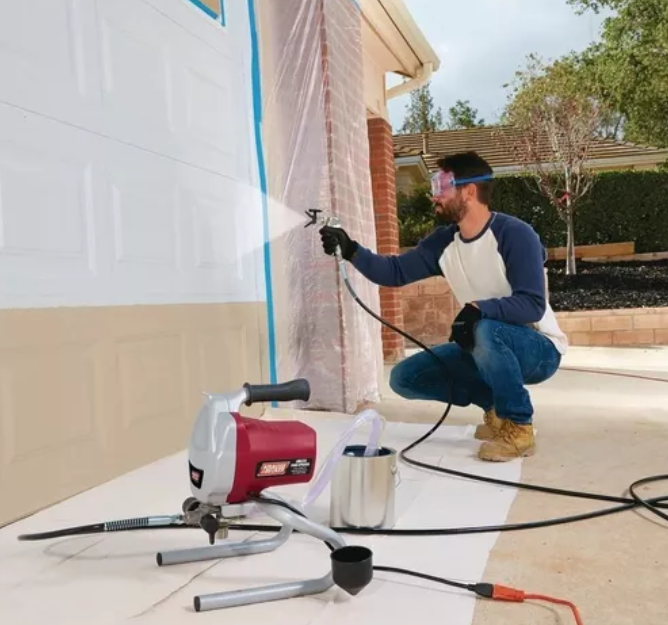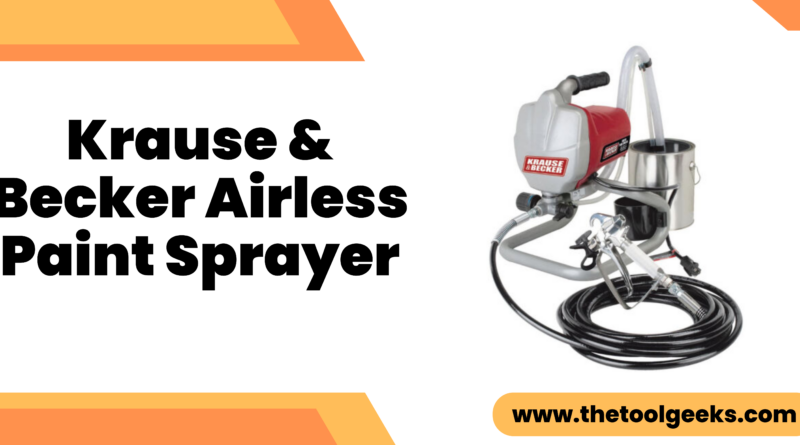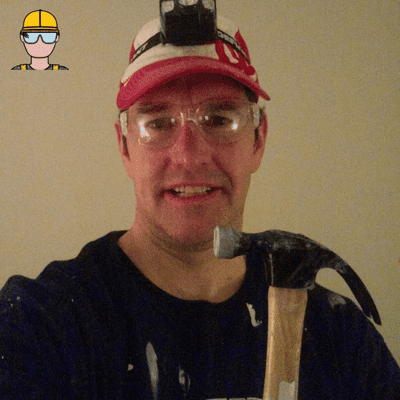The Guide to Using a Krause & Becker Airless Paint Sprayer
TheToolGeeks.com is a participant in the Amazon Services LLC Associates Program and other affiliate advertising programs. We may earn from qualifying purchases. (Learn More).
Are you looking to achieve a professional paint finish for your home or business projects at a reasonable price?
The Krause & Becker airless paint sprayer might be a helpful tool when it comes to larger painting jobs.
Jump To Page Contents:
Introduction to Krause & Becker Airless Paint Sprayer
The Krause & Becker airless paint sprayer uses airless technology to create a fine mist of paint, ensuring a smooth and even coat on various surfaces.
This name is a product brand under the Harbor Freight tools brand offering quality painting products at more affordable prices.
This airless paint sprayer is a medium-range sprayer designed to last several years at a price point significantly less than similar Graco or Titan airless sprayer models.
Advantages of Using Krause & Becker Airless Paint Sprayer

Using a Krause & Becker airless paint sprayer comes with a range of benefits:
- Efficiency and Speed
Utilizing its high-pressure mechanism, the sprayer swiftly blankets expansive surfaces, notably slashing down the time required for painting. Can pump from 1 to 5 gallon buckets.
- Uniform Finish
The airless technology ensures an even coat of paint, eliminating brush strokes and roller marks.
- Versatility
From walls to furniture, ceilings to fences, the sprayer can be used on various surfaces, both indoors and outdoors.
- Reduced Overspray
Compared to traditional sprayers, the airless design minimizes overspray, saving paint and creating less mess.
- Precision
The nozzle’s fine spray pattern allows for precise control, especially in intricate areas.
- Portabiity
Portable for an airless paint sprayer, weighing in at only 24.1 lbs and large, easy-carry handle.
How Does an Airless Paint Sprayer Work?
Central to the functionality of the Krause & Becker airless paint sprayer lies its core: a high-pressure pumping mechanism. This system pressurizes the paint and forces it through a small nozzle at an incredibly high velocity. As the paint exits the nozzle, it breaks up into tiny droplets, creating a fine spray pattern. This mechanism eliminates the need for compressed air, resulting in less overspray and a more efficient paint application.
Setting Up Your Airless Paint Sprayer
Before diving into your project, proper setup is key:
- Read the Manual
Read the user manual, to familiarize yourself with the features and demands of your particular model.
- Assembly
Follow the assembly instructions to set up the sprayer, including attaching the spray gun, hose, and nozzle.
- Safety Gear
Wear appropriate safety gear, including goggles, a mask, and protective clothing, to safeguard against paint particles and fumes.
Preparing the Surface and Paint
Achieving a flawless finish starts with surface preparation and paint mixing:
- Surface Preparation
Clean the surface thoroughly to remove dirt, grease, and debris. Sand any rough areas for a smoother result.
- Paint Mixing and Thinning
Adhere to the guidelines provided by the paint manufacturer and sprayer user manual in order to attain the desired texture and thickness level to avoid slowing the paint application.
Additionally, ensure to filter the paint to eliminate any possible clumps or imperfections.
Operating the Krause & Becker Airless Paint Sprayer: Step-by-Step Guide

Now, we’ll explore the hands-on aspects of using the Krause & Becker airless paint sprayer by breaking it down into a series of practical steps:
- Initializing the Pump
Begin by loading the paint container and priming the pump according to the provided instructions. This sets the stage for an optimal flow of paint through the system.
- Pressure Adjustment
Tailor the pressure settings to match the paint type and the surface you’re working on. Start by initially setting the pressure at a lower level, then gradually increase it while testing on a spare surface.
- Preliminary Spray
Test prior to embarking on your main project, conduct a preliminary spray test on a piece of cardboard. This ensures that the spray pattern and pressure are precisely aligned.
- Consistent Spraying
Distance to ensure uniform coverage, keep the spray gun at a steady distance from the surface. This practice helps maintain an even application of the paint.
Tips for Achieving a Professional Finish
Below, you’ll find a collection of expert recommendations to guarantee that your painting endeavor achieves a polished and professional outcome:
- Practice Makes Perfect
Develop your proficiency by practicing on a spare surface first with different pressure levels and spray patterns. This will help to acquaint yourself with the sprayer’s operation and spray pattern. A piece of cardboard or wood will do.
- Cross Over Strokes
Slightly overlap each stroke to evade streaks and guarantee complete coverage.
- Maintain a Consistent
Movement glides the sprayer smoothly and steadily to avert irregular application.
- Employ Several Thin Coats
Opt for numerous thin layers instead of a single thick coat to prevent the occurrence of drips and smudges.
Maintenance and Cleaning of Your Airless Paint Sprayer

Consistent maintenance improves the lifespan of your paint sprayer.
- Post-Use Cleaning
After each application, ensure a thorough cleansing of the sprayer elements using the suitable solvent to avert potential blockages.
- Oiling
Consistently lubricate mobile components to maintain seamless functionality.
- Storage
Place the sprayer in a well-ventilated, dry area, steering clear of excessively high or low temperatures.
Common Issues and Troubleshooting
Here’s a guide to resolving common problems with this paint sprayer:
- Clogging
In case of clogs, inspect the spray tip, nozzle, and filters for any particles. Clean them out as necessary. Cleaning the pump, hoses (suction and primer) filter, nozzle after nozzle, and spray time each use will help prevent clogging.
- Irregular Spray
Uneven spraying may be caused by incorrect pressure or a blocked nozzle. Modify the pressure or clear the nozzle accordingly.
- Paint Drips and Runs
Drips and runs can occur if the sprayer is held too closely or moved too slowly while painting. Maintain the appropriate distance and consistent motion to prevent drips and runs.
- Overspray
This paint sprayer has a tendency to overspray. Besides covering nearby objects and surfaces outside the painting surface, we recommend maintaining a constant speed when applying the paint and ensuring the spray tip is 1 foot or less or less from the painting surface.
Safety Precautions While Using the Paint Sprayer
Ensuring safety remains paramount:
- Adequate Ventilation
Operate within a well-ventilated space to reduce the inhalation of paint fumes.
- Personal Protective Equipment
Remember to don safety goggles, a mask, and suitable attire to shield against paint particles and chemical exposure.
- Electrical Precautions
Keep electrical cords clear from the painting zone to prevent any potential accidents.
Conclusion
The Krause & Becker airless paint sprayer is a versatile and affordable airless sprayer with a smaller size but able to spray larger surfaces for DIY projects and seasoned professionals alike. For more such blogs stay in touch with The Tool Geeks.
Purchase the Krause & Becker Airless Paint Sprayer
- 5/8 Horsepower
- 1000-3000 PSI Piston Pump
- Easy Twist Pressure Control
- Made of Stainless Steel
- Lightweight at 24.1 lbs
- Spray gun with built-in filter and trigger-lock
- No. 517 nozzle for 12" to 16" fan width
- Easy flushing and cleaning
Amazon and the Amazon logo are trademarks of Amazon.com, Inc, or its affiliates.


